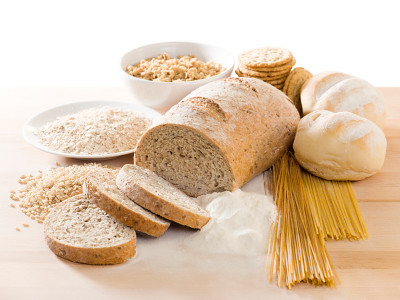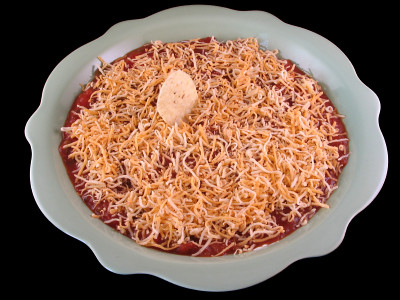 Hi Jean,
Hi Jean,I wanted to ask you if you had any experience with the “making” of food. I know that you are a nutritionist and are in a PhD program, but have you ever made specific food before?
I’m inquiring because I’m looking into “wheat and gluten free” products. My mother and sister cannot eat wheat, they have celiac disease, and are on a wheat free diet. They are doing fine, and there are a number of products available for them to eat.
I think that the whole “wheat free” diet could be a fast catching and healthy fad. It seems to me that it eliminates most carbs. Not sure where “wheat” stands on the healthy scale, or what the real health value of the food that they replace it with(rice based, gluten free products) is. But I wanted to ask if you knew anything about this.
-PJ
I actually worked as a healthy cooking instructor for a little over a year while I lived in Buffalo, NY. Though I didn't have a lot of cooking experience when I started, the cooking school was required to have an RD (registered dietitian) to teach their general health and fitness cooking class. Since the manager already knew me, I got the job, though I floundered a lot in the beginning. Let me just say, it's hard to cook four-five courses for 30 people in two hours! In any case, I'm certainly not a chef, but I do develop recipes that fit clear nutritional considerations-- my recipes are generally low-processed, high-protein, low-fat, and rich in antioxidant vitamins and minerals.
Celiac disease (CD) is a autoimmune condition (the mounts and inflammatory response against itself); the disease may be "triggered" by stressful or traumatic event, including surgery, pregnancy, childbirth, or severe infections. A person dealing with CD has a body responds very badly to the gluten protein found in wheat and some other grains, specifically: rye barley, and oats (to some extent). Gluten is created in foods when two proteins, glutenin and gliadin, are processed together to make the gluten product. For example, when kneading homemade bread-the gluten forms gives the dough elasticity and allows the bread to rise and hold a shape. Thus, it is very hard to produce gluten-free breads, because it is difficult to find a good substitute with the same shape-holding ability of gluten. Furthermore, CD is distinct from a gluten allergy.
A food allergy generally results when a whole food protein or peptide is absorbed and the body mounts a immune response to protein, which the body see as an "invader." The body's response to the food is a lot more damaging the the actual food protein, but that's how allergies work! Celiac disease, on the other hand, just completely screws up the small intestine and makes it nearly impossible for the person with CD to absorb nutrients, vitamins, or minerals. CD individuals also experience, bloating and other stomach problems, unexplained rashes, loss of energy, joint pain or may have no symptoms at all. If a CD patient continues to eat wheat, and other gluten containing foods, he or she will be at increased risk of malnutrition and other diseases over time.
For people who do not have a wheat allergy, gluten allergy, or Celiac disease, wheat is NOT unhealthy. I think the primary problem with wheat is that is such a dominant grain in our diet that dietary "variety" for many is defined as: wheat bagel for breakfast, wheat crackers for a snack, whole wheat bread at lunch, and whole wheat pasta at dinner-- catch my drift? It's all wheat and your body is continually exposed to the same irritant over and over if you have an intolerance!
There are many other good sources of carbohydrates in the Americans diet that are wheat-free for instance: rice, corn, all fruits, starchy vegetables (potatoes, peas, sweet potatoes), and legumes (including lentils and beans). Carbohydrates are a NEEDED part of the diet and should not be considered unhealthy, especially by athletes. My own carbohydrate intake ranges typically from 40-50% of my total calorie intake and my body fat has not been above 17.5% on the DXA in the last three years, this is despite an "off-season" where I do limited cardio and eat a lot more overall calories. Carbs are not bad. The wrong carbs (added sugars, corn/rice syrups, white flour, including rice flour!), over-representation of wheat in the general diet, and high intake of highly processed foods are unhealthy.
There are many gluten-free processed products out there. Except for the case of CD, I would not consider gluten-free processed products inherently healthier than regular highly-processed wheat products. On the other hand, an individual can make a healthy and varied gluten-free diet by focusing on whole foods. In fact, eating too many processed products that claim to be gluten-free may place individuals who have the problem at greater risk, since many factories may manufacture both kind of products, which presents a risk of cross-contamination!
If someone wanted to make a fad out of wheat/gluten-free, I think it's possible; however, it already been a fad for years in the bodybuilding world and in some health circles. It would also be unethical to manipulative advertising to convince the general population that they should be on a gluten-free diet. About 1% of the American population has CD; however, the number of people currently diagnosed with CD about 0.25%; so, for every person found to have CD, there are 3 to 10 more who are ignorantly living with the disease, symptoms, and chronic health risks. Personally, I would love to see population-wide Celiac testing-- a number of serious genetic condition are tested for at birth in the US, which have much lower prevalence (though more immediate detrimental effects). Though CD cannot be tested for until the age of two, the implications are serious and the incidence, 1 in 100, is high enough that early screening could improve the health of Americans and reduce long-term health care costs resulting from CD-associated chronic diseases.
 If your answer is 30-50 extra Calories per pound of added muscle, you are ... dead wrong! This muscle myth is a wide-spread and detrimental piece of misinformation; extra muscle mass will improve health, improve functional strength, and make you sizzle, but the amount of muscle gained through resistance training in the short term will not send the metabolism soaring.
If your answer is 30-50 extra Calories per pound of added muscle, you are ... dead wrong! This muscle myth is a wide-spread and detrimental piece of misinformation; extra muscle mass will improve health, improve functional strength, and make you sizzle, but the amount of muscle gained through resistance training in the short term will not send the metabolism soaring. Roasted Asparagus and Fennel
Roasted Asparagus and Fennel 


